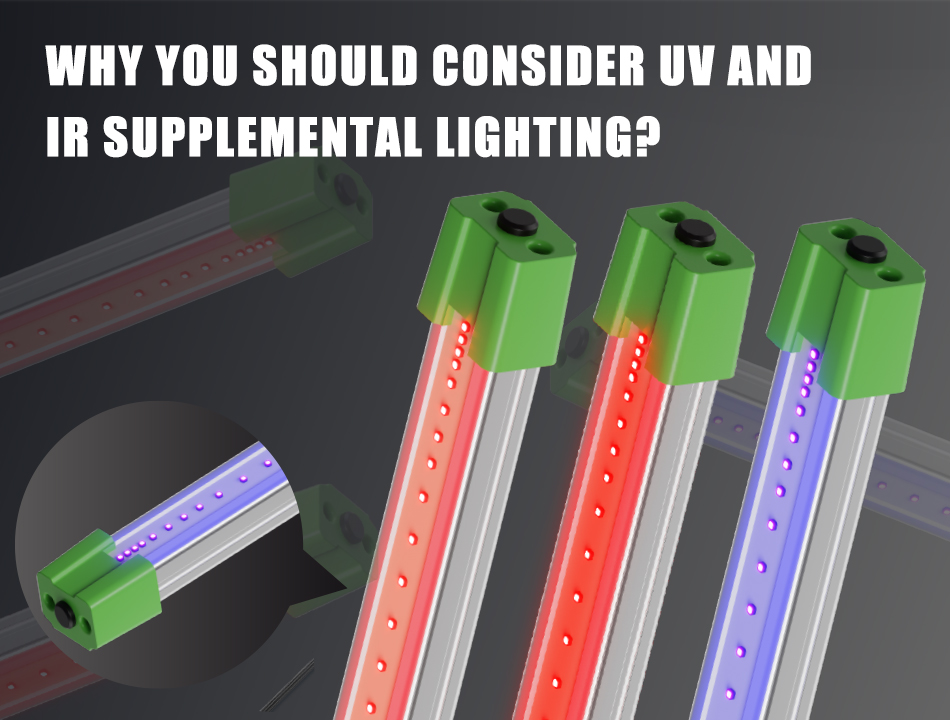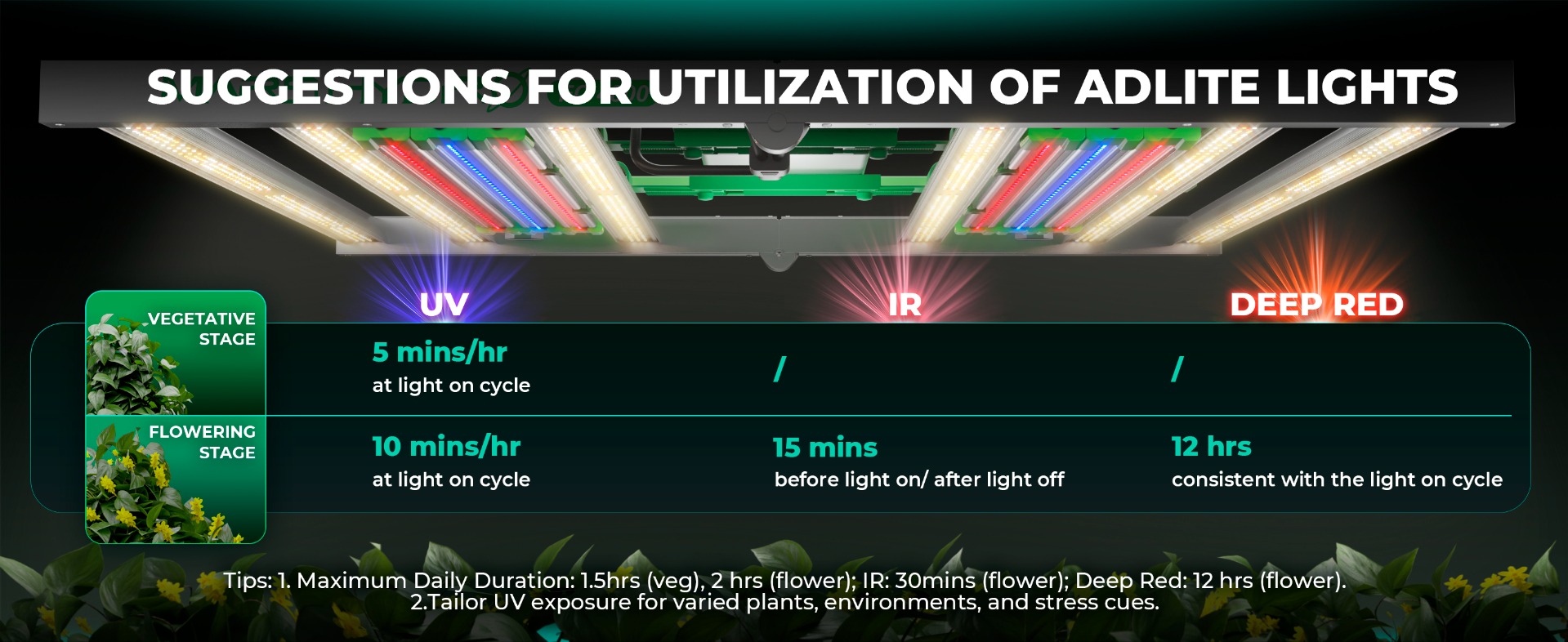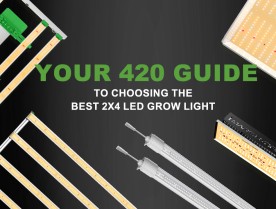
In the intricate realm of plant growth, light extends its influence far beyond the mere act of illumination. It wields the extraordinary power to intricately shape and nurture the lives of vegetation. Within the vast spectrum of light, the Ultraviolet (UV) and Infrared (IR) spectra emerge as indispensable but often underappreciated components.
UV (10nm-400nm), characterized by its shorter wavelengths, occupies the fringes of the visible spectrum, while IR (700nm-1mm), with its longer wavelengths, operates discreetly, imperceptible to our human vision. Despite their subtlety to our senses, these two spectra possess the potential to orchestrate remarkable transformations within the realm of plant physiology.
But why are these two spectra, UV and IR, so crucial in the context of plant growth? What roles do they play in the intricate dance of plant life? In this section, we shall unravel the significance of UV and IR spectra and explore why they are indispensable elements in the journey of plant development.
Table of Contents
Why UV and IR Light are Essential for Plant Growth
Exploring the impact of UV and IR light spectra on plant growth and development presents a captivating intersection of plant biology, agriculture, and technological innovation. This exploration delves deep into the ways these light spectra affect plant life, with a specific focus on boosting photosynthesis, elevating crop yield and quality, and their critical roles across different stages of plant growth.
UV light is pivotal in driving photosynthesis and fostering the production of vital secondary metabolites. In contrast, the lesser-known but equally important IR spectrum plays a subtle yet powerful role in steering plant growth and maturation, significantly contributing to improved yield and quality. Together, UV and IR light form a synergistic pair, wielding the potential to revolutionize practices in agriculture and horticulture.
The Role of UV and IR Light Spectra in Plant Growth
Enhancing Photosynthetic Efficiency
While ultraviolet (UV) light isn't a direct player in photosynthesis, its influence on plant life is profound and multifaceted. The sun showers us with UV light, predominantly in the forms of UV-A (320–400 nm) and UV-B (280–320 nm). UV light has a significant impact on the physical structure of plants. It often leads to a more compact growth form with smaller, more efficient leaves for light absorption, thereby optimizing the photosynthetic process.
UV-A, integral to plant processes like photosynthesis, aids in the synthesis of vital pigments and antioxidants. These components are vital for photosynthesis and overall plant health. Study shows, while UV light has been known for its harmful effects, in controlled amounts, UV-A contributes positively by enhancing the plant's defense mechanisms and boosting photosynthesis indirectly. By stimulating the production of protective compounds, plants can better withstand environmental stresses, leading to healthier growth and development.
UV-B influences photosynthesis indirectly. It can modify the expression of genes related to light-absorbing pigments, thus enhancing the plant’s ability to harness light energy. Research, including a study published in "Plant, Cell & Environment," has demonstrated that low doses of UV-B radiation can positively impact plant growth and photosynthesis, particularly noted in wheat. This enhancement in photosynthetic efficiency is attributed to UV-B's ability to stimulate the production of protective compounds in plants, fostering healthier growth and development.
Moreover, exposure to small amounts of UV-B radiation serves as a preparatory signal for plants, equipping them to withstand harsh environmental conditions, such as intense light. This preconditioning is believed to contribute to improved photosynthetic efficiency by enhancing the plant's overall resilience.
Infrared (IR) light, though not directly involved in photosynthesis, plays a significant role in optimizing plant growth conditions. It acts as a source of heat radiation, which is crucial for maintaining optimal temperature ranges for photosynthesis, particularly in cooler climates. It's like a warm embrace, providing heat that encourages growth, particularly stem elongation and node spacing. This is vital for overall plant health.
Researchers have observed that certain photoreceptors in plants, responding to IR light, regulate crucial processes like leaf expansion, stem growth, and even flowering. This makes IR light a key player in plant development. Additionally, IR light's ability to raise temperature is crucial. Since the optimal leaf temperature for photosynthesis in most temperate-zone plants is between 25-30°C, IR light can be a boon, especially in colder environments, by creating ideal conditions for photosynthesis to thrive.
Aditionally, NIR can increase the photosynthetic efficiency of plants by stimulating the opening of stomata, while FIR can reduce the photosynthetic efficiency by increasing the respiration rate. By creating the perfect warm environment, IR light indirectly enhances the efficiency of photosynthesis, leading to lush and vibrant plant growth.
Stimulating Secondary Metabolite Production
UV and infrared (IR) light play a pivotal role in the adaptive strategies of plants, particularly through the induction of secondary metabolite production.
When plants are exposed to UV-A and UV-B radiation, specific photoreceptor proteins within them are activated. These photoreceptors trigger complex signal transduction pathways, culminating in the synthesis of various secondary metabolites. This response is a vital part of the plant's defense mechanism against the stress induced by UV exposure. For example, Đinh et al. (2013) discovered that UV-B exposure in Nicotiana attenuata (wild tobacco) enhances the jasmonic acid burst and alters the accumulation of toxic secondary metabolites following herbivore infestation. This process increases the plant's resistance against various herbivores by boosting its secondary metabolite production.
Among the substances produced in response to UV radiation are antioxidant compounds such as polyphenols and carotenoids. These antioxidants serve a critical function in protecting the plant’s cellular structures from damage caused by free radicals. In addition to general protective compounds, UV radiation can also stimulate the production of specific secondary metabolites. For instance, it can lead to an increased synthesis of anthocyanins, which give purple flowers their distinctive color, and can boost the production of medicinal compounds in certain herbs.
Infrared radiation, commonly associated with heat, affects plants differently. It tends to raise the internal cellular temperature, which can subsequently enhance the activity of enzymes involved in metabolite production. This increase in temperature accelerates the production rate of these metabolites, helping plants cope with heat stress. Furthermore, IR radiation can influence the growth patterns of plants, prompting them to produce more secondary metabolites as a defensive response to the altered environmental conditions.
Overall, both UV and IR light are essential environmental factors that influence plant biology. They not only trigger the production of secondary metabolites as a means of adaptation and protection but also have broader implications for ecological diversity and the economic value of plants, especially in the context of agriculture and pharmacology.
Improving Yield and Quality
Incorporating UV and infrared (IR) light in agriculture has shown promising results in enhancing both the yield and quality of crops. UV and infrared (IR) light can play significant roles in improving both the yield and quality of crops in agriculture through different mechanisms:
1. Improving Crop Quality with UV Light:
- Nutritional Enhancement: UV light, especially UV-A and UV-B, has been shown to enhance the nutritional quality of crops. It activates biochemical pathways in plants that lead to the increased synthesis of vitamins and antioxidants. For example, studies have found that UV-A light can increase the concentrations of beneficial phytochemicals like beta-carotene and phylloquinone in lettuce. These compounds are crucial for human health, thereby improving the nutritional value of the crops.
- Secondary Metabolites Production: UV light can induce the biosynthesis of secondary metabolites such as flavonoids, which have antioxidant properties. These compounds not only contribute to the plant's defense mechanisms but also improve the nutritional quality of the crop.
2. Enhancing Crop Quality with IR Light:
- Sugar Content and Flavor: IR light, often associated with a rise in temperature, stimulates plants to produce more sugars. This increase in sugar content can make fruits taste sweeter and enhance their texture and flavor. Thus, IR light can be instrumental in improving the palatability and consumer appeal of fruits and vegetables.
3. Improving Crop Yield:
The application of UV light in agriculture has been shown to affect plant growth and development. For instance, certain wavelengths of UV light can induce stress responses in plants that lead to sturdier, more resilient growth.
Infrared light primarily affects plant temperature and water usage. An increase in temperature from IR light can accelerate certain biochemical processes in plants, potentially enhancing growth rates and shortening the time to harvest. This can indirectly influence the yield by allowing more crops to be grown in the same period.
UV light primarily enhances nutritional aspects and secondary metabolite production, while IR light improves sugar content and flavor. Both types of light, when applied correctly, can potentially increase crop yield by optimizing growth conditions and accelerating development.
Why Choose UV and IR Supplemental Lighting?
The utilization of ultraviolet (UV) and infrared (IR) light spectra in supplementary lighting for plant growth offers a multifaceted and highly advantageous approach. UV light, often overlooked, plays a pivotal role in enhancing photosynthetic efficiency, stimulating the production of secondary metabolites, and improving the nutritional quality of crops. On the other hand, IR light serves as a source of essential warmth, creating optimal growth conditions that indirectly enhance photosynthesis and promote the production of valuable secondary metabolites.
UV light, encompassing UV-A and UV-B, optimizes the photosynthetic process by influencing plant morphology and pigmentation. It encourages the development of more compact growth forms with efficient light absorption, leading to improved photosynthesis. UV-A contributes to the synthesis of crucial pigments and antioxidants, fortifying plant defenses and indirectly boosting photosynthesis. Controlled exposure to UV-B radiation can enhance gene expression related to light-absorbing pigments, further enhancing photosynthetic efficiency and overall plant resilience.
Additionally, UV light serves as an external stimulus that triggers the synthesis of secondary metabolites in plants. These compounds, including polyphenols, carotenoids, and anthocyanins, offer various ecological and economic benefits by defending plants against environmental stressors, providing medicinal value, and enhancing nutritional content.
In contrast, IR light provides plants with the warmth they need for optimal growth, particularly in cooler climates. It indirectly enhances photosynthesis by maintaining an ideal temperature range and promoting leaf expansion and stem elongation. By stimulating the opening of stomata and increasing enzyme activity, NIR and FIR components of IR light contribute to greater photosynthetic efficiency and the production of secondary metabolites.
In summary, incorporating UV and IR supplementary lighting into plant cultivation practices is a scientifically-backed strategy that significantly improves crop yield, quality, and overall plant health. The multifaceted benefits of these light spectra, from enhancing photosynthesis to promoting secondary metabolite production, make them indispensable tools in the realms of agriculture and plant biology.
Application Across Different Growth Stages and Suggestions
The importance of UV and IR light varies across different plant growth stages, and understanding their roles at each stage is crucial for optimizing their benefits in cultivation practices.
Application Guidelines Across Different Growth Stages

The strategic application of ultraviolet (UV) and infrared (IR) light at various stages of plant growth is essential for maximizing their benefits in cultivation. Each growth stage of a plant has different lighting requirements, and understanding how UV and IR light can be utilized during these stages is key to optimizing plant health and productivity.
1. Germination Stage:
- UV Light: Generally, UV light is not recommended during germination. Excessive UV exposure can hinder seed germination and harm young seedlings.
- IR Light: IR light is also typically avoided in this stage. The focus during germination is on maintaining stable temperature and moisture levels, which are more crucial for successful seed germination.
2. Early Vegetative Stages:
- UV Light: Introduce UV light, particularly UV-A, for about 1-2 hours per day. UV-A plays a crucial role in the synthesis of essential pigments and antioxidants, thereby enhancing seedling resilience and boosting photosynthetic efficiency. This exposure helps develop robust seedlings with efficient light absorption and strong defense mechanisms.
- IR Light: Start applying IR light for approximately 30 minutes daily, ideally before and after the main light cycle. IR light provides gentle warmth essential for stimulating early growth and development.
3. Mid to Late Vegetative Stage:
- UV Light: Continue with UV light exposure for about 1 hour daily. Consistent UV light during this stage helps maintain compact growth and enhances photosynthetic efficiency.
- IR Light: Sustain IR light exposure for around 30 minutes each day. This ongoing warmth supports leaf expansion and overall plant growth.
4. Flowering and Fruiting Stages:
- UV Light: Increase UV light to about 1.5-2 hours daily. During these stages, UV light is vital for enhancing photosynthetic efficiency and stimulating the production of secondary metabolites, which can improve the aroma and taste of fruits and flowers.
- IR Light: Continue applying IR light for 30 minutes per day. The warmth from IR light is beneficial for the development of fruits and flowers.
Adaptation and Monitoring
- Customization: These guidelines are general and should be adapted based on specific plant species, the intensity of the light source, and overall growing conditions.
- Monitoring and Adjustment: Regularly monitor plant responses to UV and IR light and adjust exposure accordingly. Be particularly cautious of UV light overexposure, as it can be detrimental.
- Integration with Other Spectra: Incorporate UV and IR light treatments within a comprehensive light cycle that includes other spectra, such as blue and green light, to ensure balanced growth.
- Experimentation: Experiment with different light regimes to find optimal conditions for specific plant species and cultivation goals.
In conclusion, effectively using UV and IR light in plant cultivation requires careful consideration of the plant’s growth stage and its specific light requirements. By tailoring light exposure to these stages and continuously monitoring plant responses, growers can leverage these light sources to enhance plant growth, health, and productivity.
Conclusion
The advantages of UV and IR supplementary lighting in plant growth are undeniable. These technologies are not just about meeting the specific light requirements of plants; they are about maximizing the potential of crops.
As we move forward in the realm of agriculture and horticulture, embracing these advanced lighting technologies could be key to unlocking higher yields and superior quality in crops. Mars Hydro encourages you to explore and harness the potential of UV and IR lighting in your agricultural endeavors. Happy farming!






